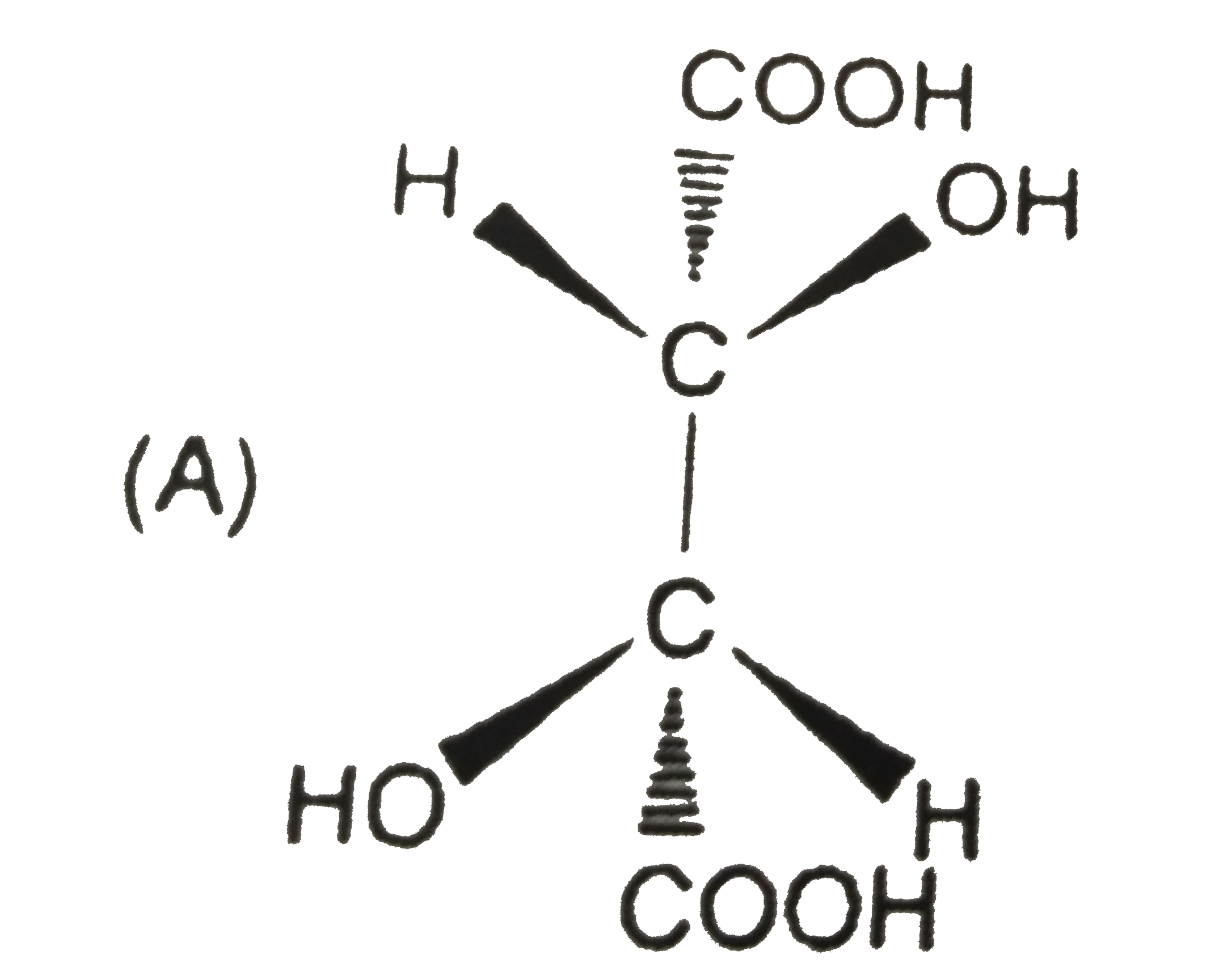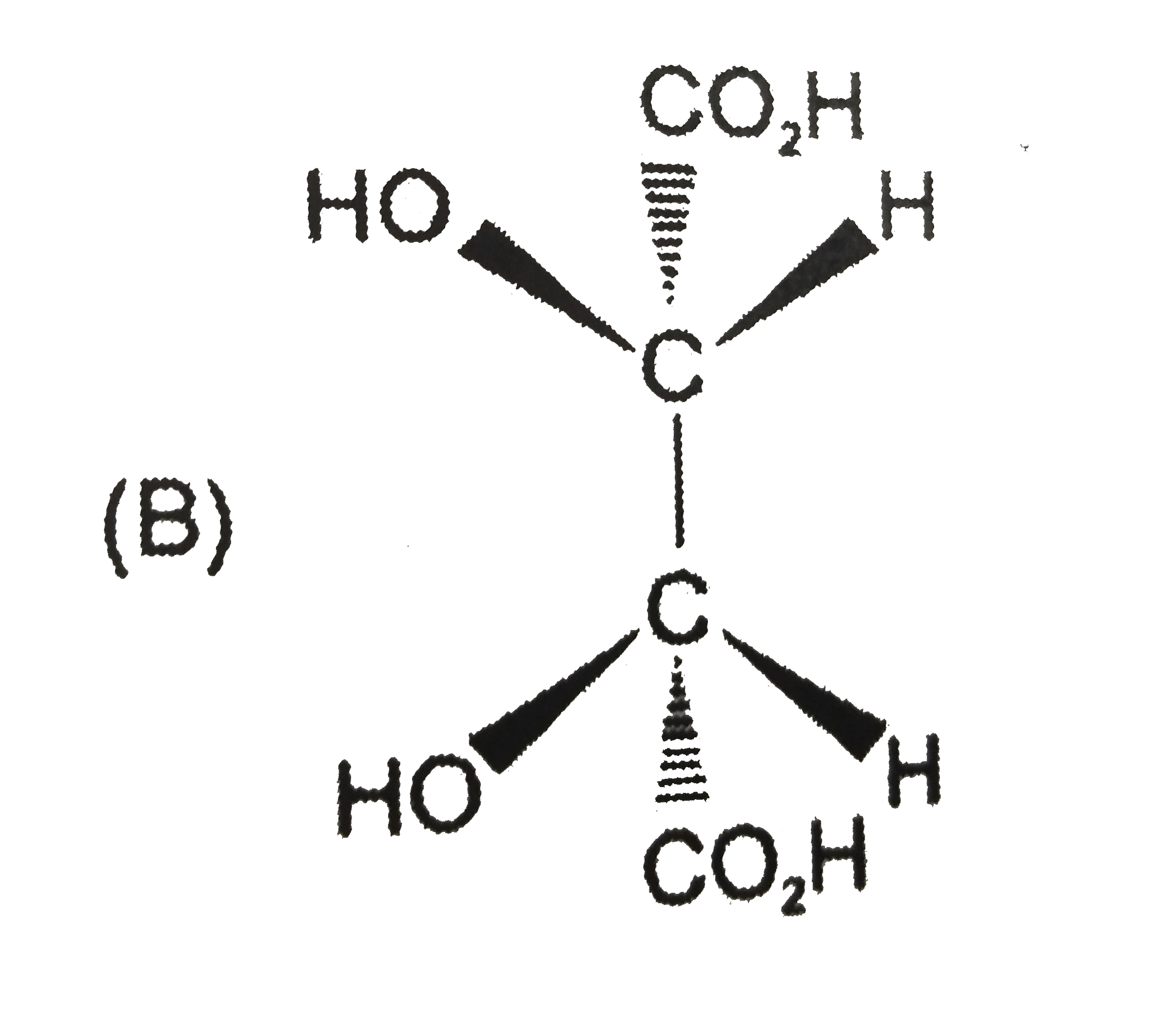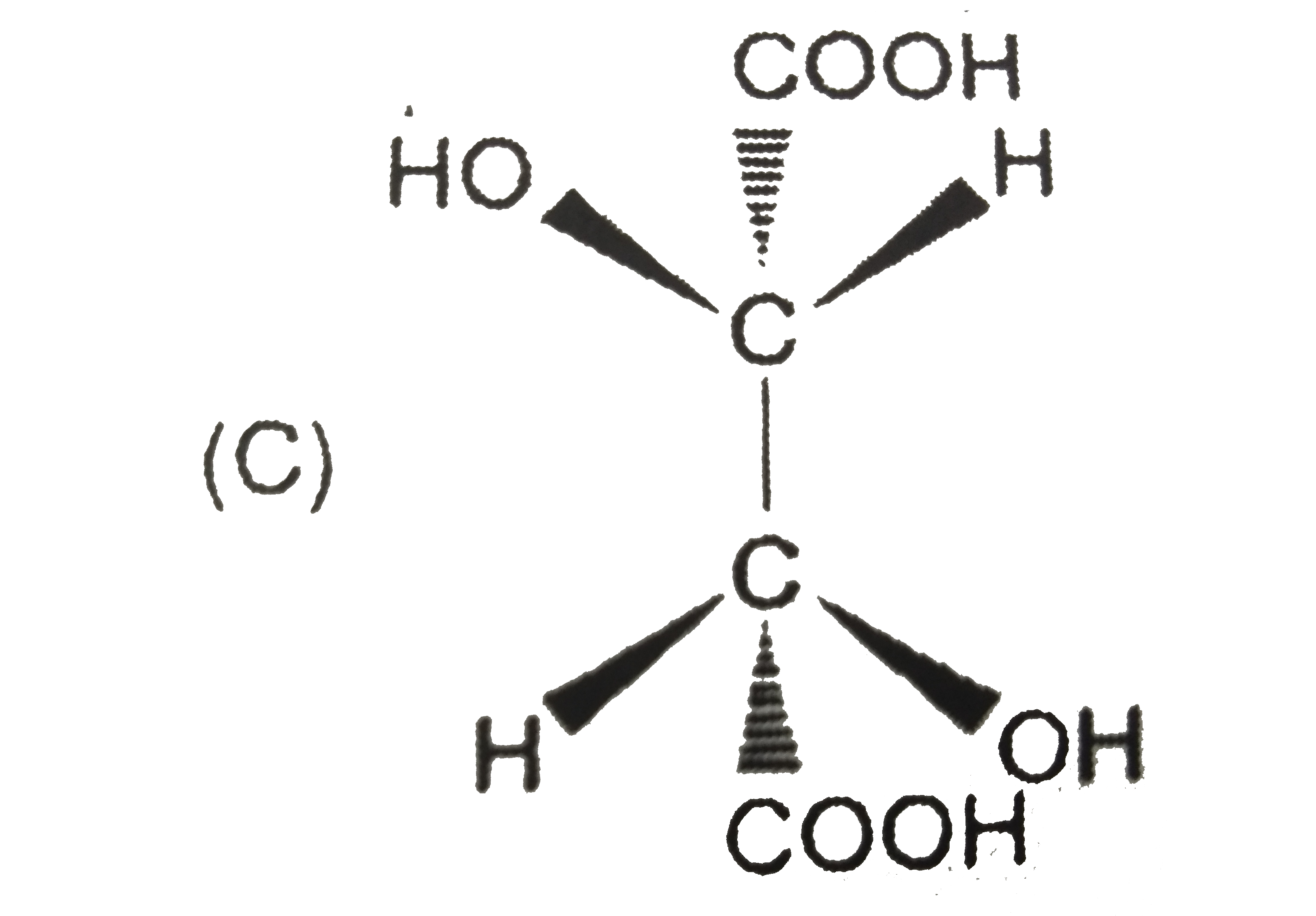Tartaric acid [HO2CH(OH)CH(OH)CO2H] was an important compound in history of stereochemistry.
Two naturally occuring forms of tartaric acid are optically inactive. One optically inactive form (P) has a melting point of 210-212∘C and can be separated into two optically acitve forms, whereas other optically inactive form (Q) cannot be resolved further.
Optically inactive form Q is



none of these
The correct Answer is:B
To determine the optically inactive form Q of tartaric acid from the given options, we need to analyze the molecular structures based on their symmetry and superimposability. Here’s a step-by-step solution:
Step 1: Understand the Concept of Optical Activity
Optical activity refers to the ability of a compound to rotate plane-polarized light. A compound is optically inactive if it does not rotate light, which typically occurs in achiral compounds or racemic mixtures.
Hint: Remember that for a compound to be optically inactive, it must either be achiral or a racemic mixture.
Step 2: Identify the Given Structures
We are given three structures of tartaric acid (let's call them A, B, and C). We need to analyze each structure to determine if they are superimposable mirror images.
Hint: Focus on the symmetry of the structures and look for any elements that would make them non-superimposable.
Step 3: Analyze Structure A
In structure A, we observe the following:
- The arrangement of functional groups is such that when we attempt to create a mirror image, the positions of the hydroxyl (OH) and hydrogen (H) atoms do not match up perfectly.
- Therefore, structure A is not superimposable and is optically active.
Hint: Check if the mirror image of the structure can be aligned perfectly with the original structure.
Step 4: Analyze Structure B
In structure B, we find:
- The two halves of the molecule are identical when we create a mirror image. The positions of the functional groups (COOH, OH, and H) are symmetrical.
- This means that structure B is superimposable on its mirror image and is thus optically inactive.
Hint: Look for symmetry in the arrangement of atoms and functional groups.
Step 5: Analyze Structure C
For structure C, we see:
- Similar to structure A, the arrangement of the functional groups does not allow for superimposition. The positions of the hydroxyl (OH) and hydrogen (H) atoms differ on either side.
- Therefore, structure C is also optically active.
Hint: Compare the arrangement of atoms in structure C with its mirror image to see if they align.
Conclusion
Based on the analysis, the only structure that is optically inactive (superimposable on its mirror image) is Structure B. Therefore, the optically inactive form Q of tartaric acid is:
Answer: Structure B
Optical activity refers to the ability of a compound to rotate plane-polarized light. A compound is optically inactive if it does not rotate light, which typically occurs in achiral compounds or racemic mixtures.
We are given three structures of tartaric acid (let's call them A, B, and C). We need to analyze each structure to determine if they are superimposable mirror images.
In structure A, we observe the following:
- The arrangement of functional groups is such that when we attempt to create a mirror image, the positions of the hydroxyl (OH) and hydrogen (H) atoms do not match up perfectly.
- Therefore, structure A is not superimposable and is optically active.
In structure B, we find:
- The two halves of the molecule are identical when we create a mirror image. The positions of the functional groups (COOH, OH, and H) are symmetrical.
- This means that structure B is superimposable on its mirror image and is thus optically inactive.
For structure C, we see:
- Similar to structure A, the arrangement of the functional groups does not allow for superimposition. The positions of the hydroxyl (OH) and hydrogen (H) atoms differ on either side.
- Therefore, structure C is also optically active.
Based on the analysis, the only structure that is optically inactive (superimposable on its mirror image) is Structure B. Therefore, the optically inactive form Q of tartaric acid is:
Topper's Solved these Questions
- STEREOISOMERISMBOOK - RESONANCE ENGLISHCHAPTER - STEREOISOMERISMEXERCISE - EXERCISE (PART -1 JEE (ADVANCED))
16 Videos
- STEREOISOMERISMBOOK - RESONANCE ENGLISHCHAPTER - STEREOISOMERISMEXERCISE - EXERCISE (PART -II JEE (MAIN))
16 Videos
- STEREOISOMERISMBOOK - RESONANCE ENGLISHCHAPTER - STEREOISOMERISMEXERCISE - EXERCISE (PART III : ONE OR MORE THAN ONE OPTIONS CORRECT TYPE)
11 Videos
- SOLUTIONSBOOK - RESONANCE ENGLISHCHAPTER - SOLUTIONSEXERCISE - Advabced Level Problems (PART-2)
35 Videos
- STRUCTURAL IDENTIFICATIONBOOK - RESONANCE ENGLISHCHAPTER - STRUCTURAL IDENTIFICATIONEXERCISE - Advanced level Problems (Part-III)
12 Videos
Similar Questions
Knowledge Check
Lactic acid (2-hydroxypropanoic acid) is an optically active compound. It can be made optically inactive by
Areplacing its OH group by HBreplacing its OH group by CICreplacing its OH group by BrDnone of the above.Optically active isomer (A) of (C5H9Cl)on treatment with one mole of H2 gives an optically inactive compound (B) compound (A) will be :
ACH3−CH∣CH2Cl−CH=CH2BCl−CH∣CH3=CH−CH3CCH3−CH∣Cl−CH2−CH=CH2DCH3−CH2−CH∣Cl−CH=CH2
Optically active isomer (A) of (C5H9Cl) on treatment with one mole of H2 gives an optically inactive compound (B) compound (A) will be :
View SolutionThe compound Co(en)2(NO2)2CI has been prepared in these isomeric forms A,B and C A does not react with AgNO3 or (en) and is optically inactive B reacts with AgNO3 but not with (en) and is optically inactive C is optically active and reacts with both AgNO3 and (en) identify each of these isomeric forms and draw their structures .
View SolutionCompound (A) C5H8O2 liberated CO2 on reaction with sodium bicarbonate. It exists in two forms neither of which is optically active. It yielded compound (B) C5H10O2 on hydrogenation. Compound (B) can be separated into enantiomorphs. Write structures of (A) and (B).
View SolutionAn optically inactive amine (A) is methylated with excess of CH3I and there after reacted with AgOH to form alkene (B). The alkene B after ozonolysis gives HCHO and CH3CH2CH2CHO. A and B in the reaction are respectively.
View SolutionCompound which rotates the plane polarised light is known as optically active compound . On the basis of direction of rotation two forms of an optically active compounds are termed as dextro and laevo rotatory . The two are termed as enantiomers . If we have a 1 : 1 mixture of d and l isomers of a given chiral compound , optical rotation of such mixture is zero Such a mixture is optically inactive and is called a recemic modification.
The net specific rotation of any mixture of the d and isomers of a given chiral compound is equal to the weighted average of the rotations due to both the isomers Mathematically if can be expressed as :
[α]≠t=fd[αd]+f1[αl]
Where fa and fl are fractions of d and l isomers respectively and [αd],[αl] are their specific rotations
The pure d isomer of certain chiral compound has
[α]25d=+55∘.A non racemic mixture of this compound has a net [α]25d=−11∘. What is the fractions of this isomer in mixture ?
View SolutionAn optically active compound [A] C5H13N reacts with alkaline CHCl3 to give an optically active, compound [B]. [A] also reacts with nitrous acid to give an optically inactive alcohol [C] C5H11OH as the major product. What would be the structure of [A]?
View Solution
